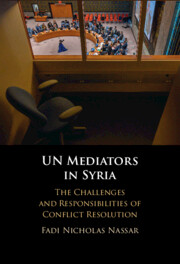1 - Introduction
Dispelling the Fog of Peacemaking
Published online by Cambridge University Press: 16 May 2024
Summary
The Introduction outlines the main objectives of the book: to pinpoint the agency of UN mediators as decision-makers and explain the strategic-thinking behind their decision-making. To do so, it bridges the literature surrounding levels of analysis in international relations and foreign policy analysis with scholarship focused on mediation. By bridging knowledge from scholars who have focused on first-level analysis, or the role of the individual in shaping policy, this chapter finds that mediators are an opportune case-study for such a method. Ultimately, by exploring the world of the mediator, with the tools developed in foreign policy analysis, the political behavior of these individuals and the phenomena of mediation can be better explained. Given the focus on UN mediators and the Syrian conflict, the chapter ends with an institutional analysis of the margin of maneuver UN mediators have as well as a detailed discussion on why the UN’s mediation process in Syria is linked to its raison d’être.
Keywords
- Type
- Chapter
- Information
- UN Mediators in SyriaThe Challenges and Responsibilities of Conflict Resolution, pp. 1 - 34Publisher: Cambridge University PressPrint publication year: 2024

